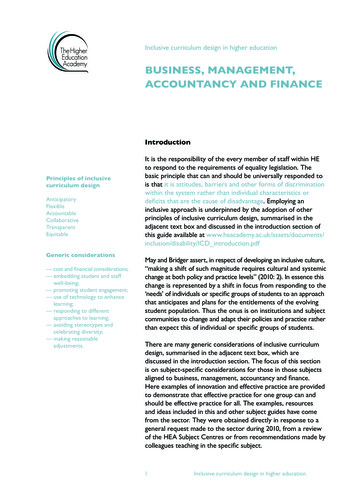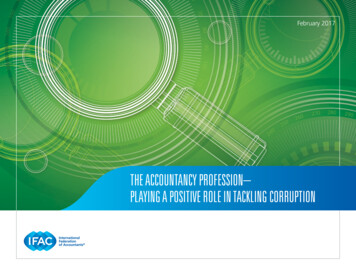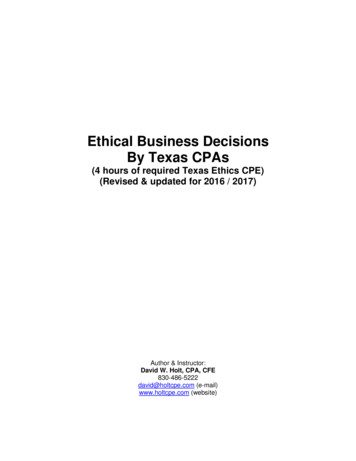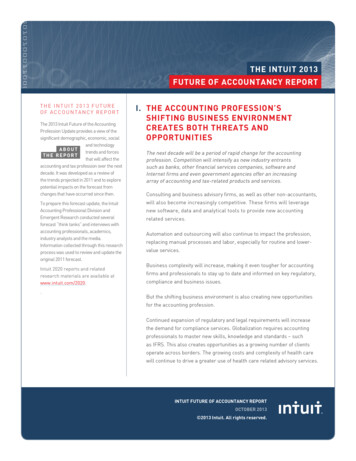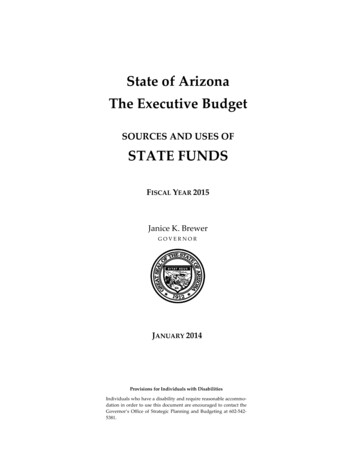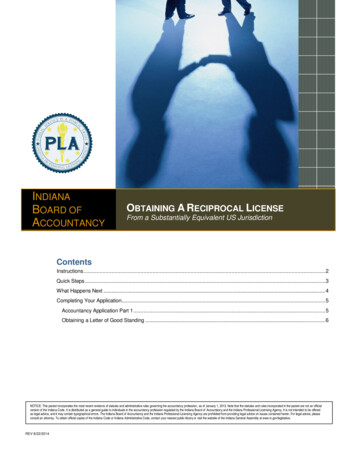
Transcription
English for Accountancy/Inglés para contabilidadLuisa Fernanda Lassaque1English for Accountancy - Inglés para ContabilidadAutora: Luisa Fernanda Lassaque
Lassaque, Luisa FernandaInglés para contabilidad : english for accountancy - 1a ed. Buenos Aires : el autor, 2006.E-Book.ISBN 987-05-0447-71. Inglés Técnico Contable-Enseñanza. I. TítuloCDD 420.7Fecha de catalogación: 12/01/2006Queda hecho el depósito que marca la ley 11.723 Luisa Fernanda LassaqueEditora: Luisa Fernanda LassaqueISBN 987-05-0447-7Queda prohibida su reproducción total o parcial, por cualquier medio, sin elconsentimiento por escrito de la autora.2English for Accountancy - Inglés para ContabilidadAutora: Luisa Fernanda Lassaque
1 - Términos básicos para contabilidad / Basic accounting termsUna duda frecuente que se plantea es ¿qué diferencia hay entre “accounting/accountancy” y“bookkeeping”? ¿Cuándo se usan unos y otros?“ACCOUNTANCY” se nos presenta como un término más abarcativo que “BOOKKEEPING”; mientrasque “BOOKKEEPING” implica solamente la teneduría de libros, es decir, transcribir en forma deasientos las operaciones diarias de una empresa (ventas que se reflejan en facturas emitidas,compras que se reflejan en salidas de dinero de caja y en la existencia de facturas que justificanesas compras), la palabra “ACCOUNTANCY” sugiere una tarea mucho más amplia y abarcativa,cual es la de analizar e interpretar los datos financieros y económicos asentados en libros por partedel tenedor de libros, para luego poder exponer un balance, valuar activos, confeccionar unacertificación, etc. mediante la aplicación de principios y normas contables.La definición de “ACCOUNTANCY”, tomada de un diccionario de origen estadounidense, es:“British term referring to the activities and theories comprising accounting including practice,research and teaching. It includes the guidelines, principles, and procedures accountants are tofollow in conducting their tasks. Accountants have legal and ethical responsibilities to their clientsand public”.Otra de las diferencias que se aprecian a partir de la definición precedente es que un“BOOKKEEPER” no tiene la misma responsabilidad que un “ACCOUNTANT”. En este segundo caso,existe una responsabilidad profesional de reflejar fielmente el estado de situación de un individuo ouna empresa, contablemente hablando, bajo pena de ser penalizado con la exoneración de sumatrícula profesional. En el caso del “BOOKKEEPER”, o del “BOOKKEEPING”, tal responsabilidadse encuentra minimizada, dado que la función natural del tenedor de libros es la mera realizaciónde una tarea manual, la registración en el sistema de partida doble (que no conlleva unaresponsabilidad profesional equivalente a la del contador), que será luego parte integrante de losprocedimientos y normas de que se vale un contador para llegar a formular, como último paso delciclo contable, los estados contables de la empresa.La palabra “ACCOUNTANCY” nos refiere a la ciencia contable y a la posibilidad de analizar yprocesar información; en consecuencia, a la posibilidad de generar nuevo conocimiento a través deellas, mientras que la palabra “BOOKKEEPING” nos refiere a la técnica contable, una serie de pasosque se aplican repetitivamente sin grandes posibilidades de introducir variantes. Como tercertérmino, tenemos a “ACCOUNTING”. “ACCOUNTING” nos remite al proceso contable, es decir, a laregistración, selección, interpretación y exposición de la información contable para ser brindada aterceros interesados en ella. El término “ACCOUNTING” también nos habla de los múltiplesaspectos que tienen relación con la registración contable de la actividad comercial: el aspectoimpositivo de un proceso contable, el aspecto referido a control, o auditoría, el análisis delcomportamiento financiero de dicha actividad comercial, entre otros.La definición en inglés de “ACCOUNTING” es la siguiente:3English for Accountancy - Inglés para ContabilidadAutora: Luisa Fernanda Lassaque
1) umbrella term encompassing the multitude of disciplines including auditing, taxation, financialstatement analysis, and managerial accounting. Accounting-related functions include financialaccounting, cost accounting, not-for-profit accounting, and financial planning.2) process of recording, measuring, interpreting, and communicating financial data.Theaccountant prepares financial statements to reflect financial condition and operatingperformance. Also, the accounting practitioner renders personal accounting services to clientssuch as preparing personal financial statements and tax planning.2 - More about the distinction between bookkeeping and accountingThere is some confusion over the difference between “bookkeeping” and “accounting”. This ispartly due to the fact that the two are related.Bookkeeping is the recording of business data in a prescribed manner. A bookkeeper may beresponsible for keeping all of the records of a business or of only a small segment, such as aportion of the customer accounts in a department store. Much of the work of the bookkeeper isclerical in nature and is increasingly being handled by mechanical and electronic equipment.Accounting is primarily concerned with the design of the system of records, the preparation ofreports based on the recorded data, and the interpretation of the reports. Accountants often directand review the work of bookkeepers. The larger the firm, the greater is the number of levels ofresponsibility and authority. The work of accountants at the beginning levels may possibly includesome bookkeeping. In any event, the accountant must have a much higher level of knowledge,conceptual understanding, and analytical skill than is required of the bookkeeper.3 – Grupos de afinidad con “accounting” / Collocations with the word“accounting”Todos los giros que se enumeran a continuación designan algo que tiene que ver con lo contable(control contable, ciclo contable, ecuación contable, entre otros), y todos ellos tienen antepuesta lapalabra “accounting” debido a su función adjetiva (en lugar de “accountancy”).ACCOUNTING CHANGE: cambio/modificación contable. En inglés “a change in: 1) accountingprinciples (such as a new depreciation method); 2) accounting estimates”.ACCOUNTING CONTROL: control contable, mediante procedimientos que garantizan lacorrección de la tarea de registración. En inglés: “procedures used to assure accuracy in the recordkeeping function. Controls exist to make certain source data placed in the system are proper andcorrect”.4English for Accountancy - Inglés para ContabilidadAutora: Luisa Fernanda Lassaque
ACCOUNTING CONVENTION: convención contable, en forma de métodos o procedimientos. Eninglés: “methods or procedures employed generally by accounting practitioners. They are basedon custom and are subject to change as new developments arise”.ACCOUNTING CYCLE: ciclo contable. En inglés: “series of steps in recording an accounting eventfrom the time a transaction occurs to its reflection in the financial statements; also calledbookkeeping cycle. The order of the steps in the accounting cycle are: 1) transactions areanalyzed; 2) transactions are journalized and posted to the ledger; 3) trial balance is prepared; 4)data needed to adjust the accounts are assembled; 5) work sheet is prepared; 6) financialstatements are prepared; 7) adjusting entries are journalized and posted to the ledger; 8) closingentries are journalized and posted to the ledger; 9) post-closing trial balance is prepared”.ACCOUNTING ENTITY: entidad/unidad contable. En inglés: “business or other economic unit(including subdivisions) being accounted for separately. A system of accounts is kept for the entity.An accounting entity is isolated so that recording and reporting for it are possible. Examples ofaccounting entities are corporations, partnerships, trusts, and industry segments”.ACCOUNTING EQUATION: ecuación contable. En inglés: “double entry bookkeeping wherethere is an identity of debit and credit elements of a transaction. For each transaction, the totaldebits equal the total credits. For example, the payment of 100 to a creditor requires a debit toaccounts payable and a credit to cash for 100. The accounting equation can also be expressedas:Assets Liabilities CapitalAn increase (or decrease) in total assets is accompanied by an equal increase (or decrease) inliabilities and capital”.ACCOUNTING ERROR: error contable. En inglés: “inaccurate measurement or representationof an accounting-related item not caused by intentional fraud. An error may be due to negligenceor may result from the misapplication of generally accepted accounting principles (GAAP). Errorsmay take the form of dollar discrepancies or may be compliance errors in employing accountingpolicies and procedures. Erros can be minimized by diligently following accounting procedures andstandards, and maintaining proper internal control”.ACCOUNTING EVENT: transacción/operación. En inglés “transaction entered in the accountingrecords of a business. It can be an external transaction -that is, one with an outsider, such asrecording a sale. It can also refer to an internal transaction, such as making an adjusting entry(e.g., expense or revenue accrual)”.ACCOUNTING MANUAL: manual contable/manual de contabilidad. En inglés: “handbookcontaining policy guidelines, procedures, and standards for accounts of a company or an individual.The chart (or classification) of accounts is part of the accounting manual”.ACCOUNTING MEASUREMENT: mensuramiento contable. En inglés: “quantification ofaccounting values in the form of money or other units. Transactions are recorded in the accounts5English for Accountancy - Inglés para ContabilidadAutora: Luisa Fernanda Lassaque
in dollars based on historical cost. Some accounting measurements have to be expressed involume such as direct labor hours used to apply overhead in a cost accounting system”.ACCOUNTING PERIOD: período contable/ejercicio. En inglés: “time covered by financialstatements which can be for any length but is usually annual, quarterly, or monthly. The annualfinancial statements may be on a calendar or fiscal year basis. Quarterly (interim) financialstatements are common and required of publicly-owned companies”.ACCOUNTING POLICIES: políticas contables. En inglés: “reporting methods, measurementsystems, and disclosures used by a specific company. The accountant should evaluate theappropriateness of accounting policies employed by management. A description of the company’saccounting policies should be presented in a separate section preceding the footnotes to thefinancial statements or as the first footnote. Disclosure of accounting policies should includeaccounting principles and methods of application that involve: (1) a selection from generallyaccepted alternatives; (2) those peculiar to the industry or field of endeavor; and (3) unusual ordifferent applications of generally accepted accounting principles (GAAP). Examples of disclosuresare basis of consolidation, depreciation methods, and inventory pricing. Disclosure of accountingpolicies assists financial readers in better interpreting a company’s financial statements. Thus, itresults in fair presentation of the financial statements”.ACCOUNTING PRACTICE: práctica contable. En inglés: “manner in which accountants andauditors carry out their daily work. It is the day-to-day implementation of accounting policies.Accounting practice relates to the practical application of accounting to the financial accumulationand reporting needs of clients. Practice may differ from accounting theory”.ACCOUNTING PRINCIPLES: principios contables. En inglés: “rules and guidelines ofaccounting. They determine such matters as the measurement of assets, the timing of revenuerecognition, and the accrual of expenses. The “ground rules” for financial reporting are referred toas generally accepted accounting principles (GAAP). To be “generally accepted”, an accountingprinciple must have “substantial authoritative support” such as by promulgation of a financialaccounting standards boards (FASB) pronouncement. Accounting principles are based on theimportant objectives of financial reporting. An example of an accounting principle is accrual”.ACCOUNTING PROCEDURE: procedimiento contable. En inglés: “method or technique usedto uncover, record, or summarize financial data in the preparation of financial statements”.ACCOUNTING RECORDS: registros (libros) contables. En inglés: “various journals (e.g., cashreceipts journal, general journal), ledgers (e.g., general ledger, subsidary ledger), and the sourcesof information for these formal records such as sales invoices, checks, vouchers, and writtenagreements”.ACCOUNTING SOFTWARE: software/programas contables. En inglés: “programs used tomaintain books of account on computers. The software can be used to record transactions,maintain account balances, and prepare financial statements and reports. An accounting softwarepackage typically contains numerous integrated modules (for example, spreadsheet and wordprocessing abilities). Some modules are used to account for the general ledger, accountsreceivable, accounts payable, payroll, inventory, and fixed assets”.6English for Accountancy - Inglés para ContabilidadAutora: Luisa Fernanda Lassaque
ACCOUNTING STANDARDS: normas contables. En inglés:accountants as formulated by an authoritative body or law.“conduct to be followed byACCOUNTING SYSTEM: sistema contable. En inglés: “methods, procedures, and standardsfollowed in accumulating, classifying, recording, and reporting business events and transactions.The accounting system includes the formal records and original source data. Regulatoryrequirements may exist on how a particular accounting system is to be maintained (e.g., insurancecompany)”.ACCOUNTING VALUATION: valuación contable. En inglés: “valuation of assets in accounting.Correct valuation is important. If, for example, an asset is valued incorrectly, it is impossible todraw accurate conclusions about a firm’s liquidity or its value in liquidation. Valuation is usuallymade in accordance with generally accepted accounting principles (GAAP)”.4 - Areas de especialización contable / Specialized accounting fieldsAs in many other areas of human activity during the twentieth century, a number of specializedfields in accounting have evolved as a result of rapid technological advances and acceleratedeconomic growth. The most important accounting fields are described briefly in the followingparagraphs:Financial accounting is concerned with the recording of transactions for a business enterprise orother economic unit and the periodic preparation of various reports from such records. Thereports, which may be for general purposes or for a special purpose, provide useful information formanagers, owners, creditors, governmental agencies, and the general public. Of particularimportance to financial accountants are the rules of accounting, termed generally acceptedaccounting principles. Corporate enterprises must employ such principles in preparing theirannual reports on profitability and financial status for their stockholders and the investing public.Comparability of financial reports is essential if the nation’s resources are to be divided amongbusiness organizations in a socially desirable manner.Auditing is a field of activity involving an independent review of the accounting records. Inconducting an audit, public accountants examine the records supporting the financial reports of anenterprise and give an opinion regarding their fairness and reliability. An important element of“fairness and reliability” is adherence to generally accepted accounting principles. In addition toretaining public accountants for a periodic audit, many corporations have their own permanentstaff of internal auditors. Their principal responsibility is to determine if the various operatingdivisions are following management’s policies and procedures.Cost accounting emphasizes the determination and the control of costs. It is concernedprimarily with the costs of manufacturing processes and of manufactured products. In addition,one of the most important duties of the cost accountant is to gather and explain cost data, bothactual and prospective. Management uses these data in controlling current operations and inplanning for the future.7English for Accountancy - Inglés para ContabilidadAutora: Luisa Fernanda Lassaque
Management accounting uses both historical and estimated data in assisting management indaily operations and in planning future operations. It deals with specific problems that confrontenterprise managers at various organizational levels. The management accountant is frequentlyconcerned with identifying alternative courses of action and then helping to select the best one.For example, the accountant may assist the company treasurer in preparing plans for futurefinancing, or may develp data for use by the sales manager in determining the selling price to beplaced on a new product. In recent years, public accountants have realized that their training andexperience uniquely qualify them to advise management personnel on policies and administration.This rapidly growing field of specialization by CPAs is frequently called management advisoryservices or administrative services.Tax accounting encompasses the preparation of tax returns and the consideration of the taxconsequences of proposed business transactions or alternative courses of action. Accountantsspecializing in this field, particularly in the area of tax planning, must be familiar with the taxstatutes affecting their employer or clients and also must keep up to date on administrativeregulations and court decisions on tax cases.Accounting systems is the special field concerned with the design and implementation ofprocedures for the accumulation and reporting of financial data. The systems accountant mustdevise appropriate “checks and balances” to safeguard business assets and provide for informationflow that will be efficient and helpful to management. Familiarity with the uses and relative meritsof various types of data processing equipment is also essential.Budgetary accounting presents the plan of financial operations for a period and, throughrecords and summaries, provides comparisons of actual operations with the predetermined plan. Acombination of planning and controlling future operations, it is sometimes considered to be a partof management accounting.International accounting is concerned with the special problems associated with theinternational trade of multinational business organizations. Accountants specializing in this areamust be familiar with the influences that custom, law, and taxation of various countries bring tobear on international operations and accounting principles.Not-for-profit accounting specializes in recording and reporting the transactions of variousgovernmental units and other not-for-profit organizations such as churches, charities, andeducational institutions. An essential element is an accounting system that will insure strictadherence on the part of management to restrictions and other requirements imposed by law, byother institutions, or by individual donors.Social accounting is the newest field of accounting and is the most difficult to describe in a fewwords. There have been increasing demands on the profession for measurement of social costsand benefits which have previously been considered to be unmeasurable.One of theengagements in this field involved the measurement of traffic patterns in a densely populatedsection of the nation. This effort was part of a government study to determine the best use oftransportation funds, not only in terms of facilitating trade but also of assuring a good environmentfor the area’s residents. Other innovative engagements have dealt with the best use of welfarefunds in a large city, with the public use of state parks, with wildlife in state game preserves, andwith statewide water and air pollution.8English for Accountancy - Inglés para ContabilidadAutora: Luisa Fernanda Lassaque
Accounting instruction, as a field of specialization, requires no explanation. However inaddition to teaching, accounting professors often engage in research, auditing, tax accounting, orother areas of accounting on a part-time or consulting basis.There is some overlapping among the various fields, and leaders in any particular field are likely tobe well versed in related areas. There is also a considerable degree of specialization within aparticular field. For example, in auditing one may become an expert in a single type of businesenterprise such as department stores or public utilities. In tax accounting one may become aspecialist in oil and gas producing companies. In systems one may become an expert in electronicdata processing equipment.5 - More accounting-related words you needENTRY: asiento; en inglés: recording of a transaction in the books of account, such as the receiptof cash in the cash receipts journal.ADJUSTING ENTRY / ADJUSTMENT ENTRY: asiento de ajuste; aquél destinado a corregir erroresu omisiones en que se ha incurrido en la contabilidad.CLOSING ENTRY: asiento de cierre. Se trata de un asiento contable que tiene por objeto llevara cero el saldo de las cuentas de resultado y transferir a la cuenta de resultados acumulados laganancia o pérdida del período contable, sea mensual o anual. El procedimiento consiste endebitar las cuentas con saldo acreedor y acreditar las que tienen saldo deudor por esos mismosimportes.A DEBIT ENTRY / A CREDIT ENTRY: débito/crédito (contable)Otra de las dudas que se plantean, sobre todo al tener que escribir un texto directamente eninglés, o al tener que traducir del castellano al inglés, es con las palabras “recording” y“registration”:mientras la definición indica que ambas pueden, en ocasiones, usarseindistintamente, la práctica, los textos nativos prefieren uno a otro.REGISTRATION: registración; en inglés, tiene tres acepciones: “1) act or fact of making an entryof any class of transactions or statements for the purpose of documentation for future reference.Such documentation may be in the form of financial information noted in registers, such as a cashregister; 2) process set up by the Securities and Exchange Acts of 1933 and 1934 that requirespublicly issued securities to be reviewed by the SEC; 3) recording of stocks or bonds in the owner’sname as opposed to bearer’s name.La primera acepción se refiere a una registración contable; también puede encontrársela, eninglés, como RECORDING; la segunda acepción hace referencia al proceso que debe realizarseante la SEC, en los Estados Unidos, entidad equivalente a la Comisión Nacional de Valores enArgentina: las acciones que se negocian en rueda de bolsa deben estar registradas ante la SECpara su revisión periódica; y, en tercer lugar, “REGISTRATION” hace referencia a la registraciónnecesaria para las acciones nominativas, en oposición a las acciones al portador.9English for Accountancy - Inglés para ContabilidadAutora: Luisa Fernanda Lassaque
WRITE-DOWN: consiste en la reducción, en términos contables, del valor de un activo; porejemplo, debido a su obsolescencia. Su definición en inglés: “reduction of part of the balance ofan asset by charging an expense or loss account. The reason for a write-down is that someeconomic event has occurred indicating that the asset’s value has diminished. An example is theobsolescence of some inventory”.WRITE-OFF: dar de baja; 1) transfer of the entire balance of an asset account into an expense orloss account. A full reduction in an asset indicates it is not worth anything (has no future benefit)due to some occurrence. An example is the destruction of a machine in a fire when the companyhas no insurance and the machine no salvage value; 2) elimination of a specific customer’s accountbalance because of uncollectibility, as in the case of a bankruptcy.ACCOUNT: cuenta; systematic arrangement showing the effect of transactions and other eventson a specific balance sheet or income statement item. An account is usually expressed in money.BOOKKEEPING: teneduría de libros; accounting support functions performed by the bookkeeper.Bookkeeping is the most basic of the accounting duties and requires less education andexperience.BOOKKEEPER: tenedor de libros; individual basically concerned with accounting supportfunctions within the firm. Duties include recording journal entries in the various journals, postingand maintaining the ledger, preparing a trial balance, making up the payroll, and preparing a bankreconciliation.ACCOUNTANT: contador; one who performs accounting services. Accountants prepare financialstatements and tax returns, audit financial records, and develop financial plans. A bookkeeper isdistinguised from an accountant as one who employs lesser professional skills. The bookkeepingfunction is primarily one of recording transactions in the journal and posting to the ledger.TO POST/POSTING: mayorizar. En inglés: “to transfer from the journal to the ledger a debit orcredit to the given account involved”.BOARD OF DIRECTORS: Directorio; group of persons elected by a company’s stockholders to runthe business according to the corporate charter.BOOK: en función verbal, asentar en libros; (verb) to record an entry.BOOK: libro contable; (noun) used generally in plural, it refers to journals and ledgers.BALANCE: saldo; a difference between total debits and total credits in an account.A PUBLICLY HELD/OWNED COMPANY: empresa estatalA PRIVATELY HELD/OWNED COMPANY: empresa privadaCHART OF ACCOUNTS: plan de cuentas; a list of ledger account names and numbers arrangedin the order in which they customarily appear in the financial statements.10English for Accountancy - Inglés para ContabilidadAutora: Luisa Fernanda Lassaque
TRIAL BALANCE: balance de sumas y saldos; listing of the account balances from the generalledger, prepared at the end of the accounting period. All accounts are listed in the order in whichthey appear in the ledger. Total debits must equal total credits; otherwise, an error has beenmade.CALENDAR YEAR: año calendarioRECOGNITION: reconocimiento; recording a business occurrence in the accounting records.CONTRAASIENTO: balancing entry. Un sinónimo de “contraasiento” es “asiento de reversión”. Ladefinición es: “asiento que deshace los efectos de uno anterior; los importes antes debitados (oacreditados) son acreditados (o debitados) a las mismas cuentas.A CREDIT SALE / A SALE ON ACCOUNT / ON CREDIT: venta a crédito / al fiado / en cuentacorriente. Es la venta que se realiza sin que el comprador pague de inmediato, sino en formadiferida. THE CASH ACCOUNT INCREASED BY 5,000 AND WAS DEBITED FOR THIS AMOUNT: lacuenta “caja y bancos” se incrementó en 5.000, y se efectuó un débito por dicho monto.IF POSTING TO THE LEDGER IS DONE ACCURATELY, TOTAL DEBITS FOR ALL ACCOUNTS TAKENTOGETHER SHOULD BE EQUAL TO TOTAL CREDITS FOR ALL ACCOUNTS TAKEN TOGETHER: Si lamayorización se realiza con exactitud, los débitos de todas las cuentas deben ser iguales a loscréditos del conjunto de las cuentas.TRANSPOSITION: inversión; transposition occurs when digits of an entry are reversed, as whenthe entry 369 is entered as 639.SLIDE: slides occur when a decimal is misplaced. For example, 727.00 may be entered as 72.70or as 7270.00.CORRECTING ENTRY: asiento de ajuste; when an amount has been posted to the wrongaccount, a correcting entry is required.A 300 DEBIT: un débito por la suma de 300.THE BALANCES OF ALL OF THE REVENUE ACCOUNTS ARE CREDITED TO (ADDED TO) THEOWNER’S CAPITAL ACCOUNT: los saldos de todas las cuentas de ingresos se acreditan en lacuenta del patrimonio neto.THE BALANCES OF THE OWNER’S DRAWING ACCOUNT IS DEBITED TO (DEDUCTED FROM) THEOWNER’S CAPITAL ACCOUNT: los saldos de la cuenta de retiro del titular de la firma se debita dela cuenta del patrimonio neto.RULE / RULING: cerrar con doble línea una suma para separarla de las siguientes cifras. Whenall the closing entries have been posted to the Ledger, all accounts have their balances computed(calculated). Lines are then ruled beneath the last entries to segregate (separate) them from thetransactions to be recorded during the next accounting period.11English for Accountancy - Inglés para ContabilidadAutora: Luisa Fernanda Lassaque
CLOSE / UNCLOSE: the effect of final balancing (sacar los saldos) is to bring the balance of eachaccount forward (to bring forward the balance of each account: transportar/traspasar elsaldo) to be included in the next period’s transactions. Certain temporary accounts have beenclosed and will, therefore, have no balance (or, rather, a zero balance) to bring forward.Generally speaking, closing is done by totaling the debits and credits for each account and thenruling a double line across all columns on the account page, except the item column (la columnade “concepto”). The procedure of balancing and ruling the acocunts is slightly different for theclosed accounts then it is for the unclosed accounts. All the unclosed accounts have nonzerobalances, which are recorded a the first amount in the next accounting period.TAKE A (POST-CLOSING) TRIAL BALANCE: realizar un balance de sumas y saldos posterioral cierre; when all the accounts in the Ledger have been ruled and balanced, only one stepremains in the accounting cycle: all of the debit balances must be added, all of the credit balancesmust be added, and the two totals must be compared to test their equality. This procedure isknown as taking a Post-Closing Trial Balance.JOURNAL: Libro DiarioLEDGER: Libro MayorSUBSIDIARY JOURNAL / SUBSIDIARY LEDGER: Sub-Diario / Sub-MayorGENERAL JOURNAL / GENERAL LEDGER: Diario General / Mayor GeneralCONTROLLING ACCOUNT: cuenta controlCHECK-MARK: tilde/ tildarCROSSFOOT: procedure in which additions are made vertically as well as horizontally to assure themathematical accuracy of totals.DI
cual es la de analizar e interpretar los datos financieros y económicos asentados en libros por parte del tenedor de libros, para luego poder exponer un balance, valuar activos, confeccionar una certificación, etc. mediante la apli






